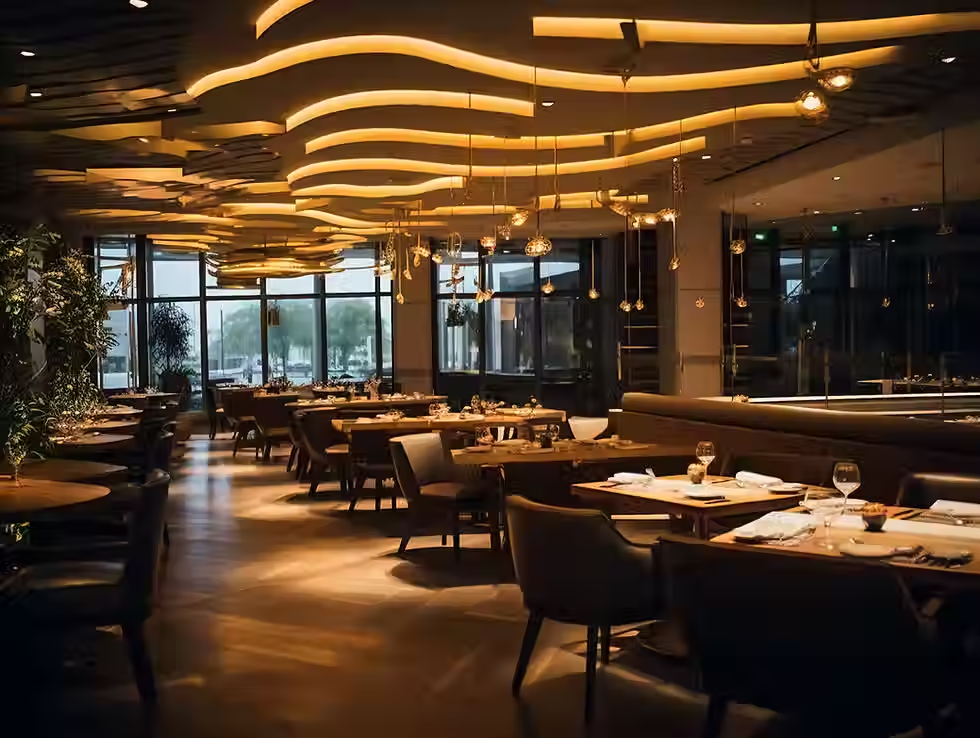Concealing Glare in Architectural Lighting Design
- vivian155
- Aug 21, 2024
- 4 min read
Have you ever been momentarily blinded by looking into bright lights? That's glare, a common yet often overlooked issue in the world of lighting. Glare not only disrupts our vision but also impacts our daily lives in ways we may not realize. As lighting designers, it's our mission to strike a balance between creating beautifully illuminated spaces and ensuring visual comfort.
In this guide we'll delve into the world of glare—what it is, why it matters, and most importantly, how we can minimize its effects. From clever design techniques to innovative technologies, discover how to achieve harmonious lighting that enhances your environment without straining your eyes. Let's illuminate your understanding of glare and explore ways to keep our vision out of the spotlight
What is glare?
Glare is generally understood as light that affects our ability to see, and occurs when a light source is excessively bright, in our line of sight, or is not properly concealed. Though this may seem straightforward, glare can be difficult to control even in the most common lighting applications. And as we age, reducing glare becomes even more important. Our eyes become more sensitive to bright light, but at the same time they require higher and more uniform light levels, where glare is more likely to occur. It’s a tricky balance, and we find that poorly selected and placed light fixtures can cause concerning discomfort and vision damage, so having some tools to reduce glare is very important!

How to reduce glare:
1. Use indirect light sources as much as possible. Indirect lighting can be categorized as lighting which reflects off surfaces (ceilings, walls, etc) within a space to diffuse light throughout. The result is a softer, natural glow which provides more even lighting. A great example of indirect lighting is cove lighting.
2. Conceal light sources as much as possible. Study the location of the light, optics, and the probability that someone will be able to look directly into the light source. Most of the time we don’t look up when walking into a room, unless you are a lighting designer yourself. However, poorly aimed or placed fixtures that can be readily viewed and cause significant discomfort.

In this project, concealed linear up lights in arched cased openings provide visual rhythm to the corridor. Further down the hall, recessed adjustable downlights are aimed at sculptural elements along the wall. With both lighting elements providing light by bouncing it off of the ceiling and walls, this lighting system provides ambiance, highlights architecture, all while providing functional light levels.
3. When using direct light sources, apply shielding mechanisms such as louvers, house side shields, snoots and “barn doors.” These items cut the beam of light off before it can be viewed directly. A major goal in lighting is to hide or conceal the light source as this effectively removes direct glare.
4. Specify tighter beam angles for illumination of specific items. Study the art size and distance from the light source and choose the optic that is most appropriate for the application.
5. Use smaller recessed adjustable fixtures to get the light exactly where you need it. For example, working surfaces, desks, and artwork or accent walls. The use of larger aperture fixed downlights with wide optics causes almost everyone who is under them to be able to see the light source directly, ouch!
6. Use dimmers! The use of dimmers gives us flexibility and smooth lighting transitions which are essential for reducing glare throughout the day and as we age. We often experience glare when we come home at night. This is because of the drastic change from dark to light. Transitioning slowly from low light levels to high light levels reduces strain on the eyes and eases us throughout the day and night.

7. Consider using warm dimming technology, which mimics the sun's natural transition from day to night, providing a comfortable lighting experience. When fully bright, fixtures emit more blue light with higher intensity. As the light dims, it shifts to a warmer color temperature with reduced output, creating a softer, more soothing atmosphere that supports relaxation and aligns with our natural circadian rhythms, minimizing the disruption caused by artificial light.
This project image shows how warm color temperatures
can make a space feel more soft and cozy at night.

Overall, a successful lighting system is one that provides visual comfort, actively improving our interactions and experience within space. This is especially important in New England, with an older demographic who are more likely to experience glare and visual discomfort. It is a careful balance between increasing light levels as we age and continuing to obstruct the light source to ease the visual experience. By integrating some of these tools to reduce glare, the overall visual experience will be one that is both comfortable and enjoyable.
To embark on your journey toward spectacular living light, seek independent professional advice, from a lighting designer. Their guidance ensures that the implementation of indirect lighting in your home is not just functional but also aesthetically rewarding.
Follow us on Instagram and LinkedIn for similar content and posts.
We send our informational newsletter quarterly.
Please share and subscribe!
-Written by Maxime O'Rourke, For Prism Lighting Design



Comments